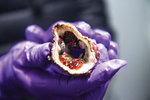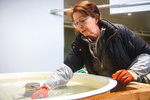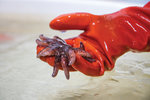The Port Townsend Marine Science Center released around 900 Pinto abalone March 11.
This item is available in full to subscribers.
We have recently launched a new and improved website. To continue reading, you will need to either log into your subscriber account, or purchase a new subscription.
If you had an active account on our previous website, then you have an account here. Simply reset your password to regain access to your account.
If you did not have an account on our previous website, but are a current print subscriber, click here to set up your website account.
Otherwise, click here to view your options for subscribing.
* Having trouble? Call our circulation department at 360-385-2900, or email our support.
Please log in to continue |
|



The babies have flown the nest.
Actually, they were scooped out of a tank.
The Port Townsend Marine Science Center released around 900 Pinto abalone March 11.
The nearly two-year-old abalone were raised by citizen scientist volunteers at the center, and are now going to be transferred to release locations near the San Juan Islands by the Puget Sound Restoration Fund.
“I’ve got empty tank syndrome,” said Dana Africa, as she helped Morgan Adkisson, a marine biologist from the Restoration Fund, scoop up the abalone to be taken away.
For the past year, Africa and two other volunteers, Sue Long and Lee Merrill with volunteer coordinator Betsy Carlson, have fed and cared for the abalone, while also doing regular counts to monitor their survival rate.
“We’re their official foster moms,” Africa joked.
Pinto abalone, prized for its mild flesh and flashy mother-of-pearl shell linings is an endangered species of marine snails with a distribution ranging from Baja California, Mexico, to Alaska. It is the only abalone species found in Washington state, British Columbia and Alaska, and therefore is referred to as the Northern Abalone.
Even though a commercial fishery for harvesting Pinto abalone was never authorized in Washington, the species had been recreationally harvested for many years. In 1959, the Pinto abalone were classified as shellfish in Washington, and a daily harvest possession limit of three per person was imposed. Throughout the years, more restrictions were added to the fishery, but the populations continued to decline, and the season has been closed since 1994, according to the Washington Department of Fish and Wildlife.
“When you take the abalone away, the otters leave,” Africa said. “Then the kelp takes over and blocks out the sun. It’s like a house of cards. Take one species away and all hell breaks loose.”
Studies conducted by the WDFW in the San Juan Archipelago, a region of historically healthy abalone populations, showed a 97 percent decline in abalone populations between 1992 and 2017.
The Marine Science Center’s raise and release program, in partnership with the Restoration Fund, is working to reverse those losses.
“This is the largest scale pinto recovery program we work with,” Adkisson said. “Once they’re in this robust stage of life, they have a pretty good chance of survival.”
Using a sea star to scare the abalone out of hiding in their tanks, Adkisson worked with Africa, Carlson, Long and Merrill to collect and transfer the marine animals to buckets. Next, she will take them to the Restoration Fund labs, where they will be placed in “outplant modules” made of PVC pipe, and slowly released into the Salish waters.
The four volunteers worked tirelessly to put a magenta dot of harmless dye on the small sea snails—each only measuring about an inch long—so that scientists can identify the pen-raised abalone and measure their survival rate in the wild.
The Marine Science Center hopes to continue the abalone restoration program in the upcoming year, said aquarist Ali Redman. The center’s aquarium will open its doors to the public for their spring season on March 29, and hope to have a new batch of abalone for visitors to watch in late spring, she said.
Those interested in becoming a citizen scientist and volunteering at the aquarium, or working with the abalone can attend a volunteer orientation meeting to learn more. The meetings occur monthly. The next meeting is at 4 p.m. on April 16 at the center’s museum, located at Fort Worden.